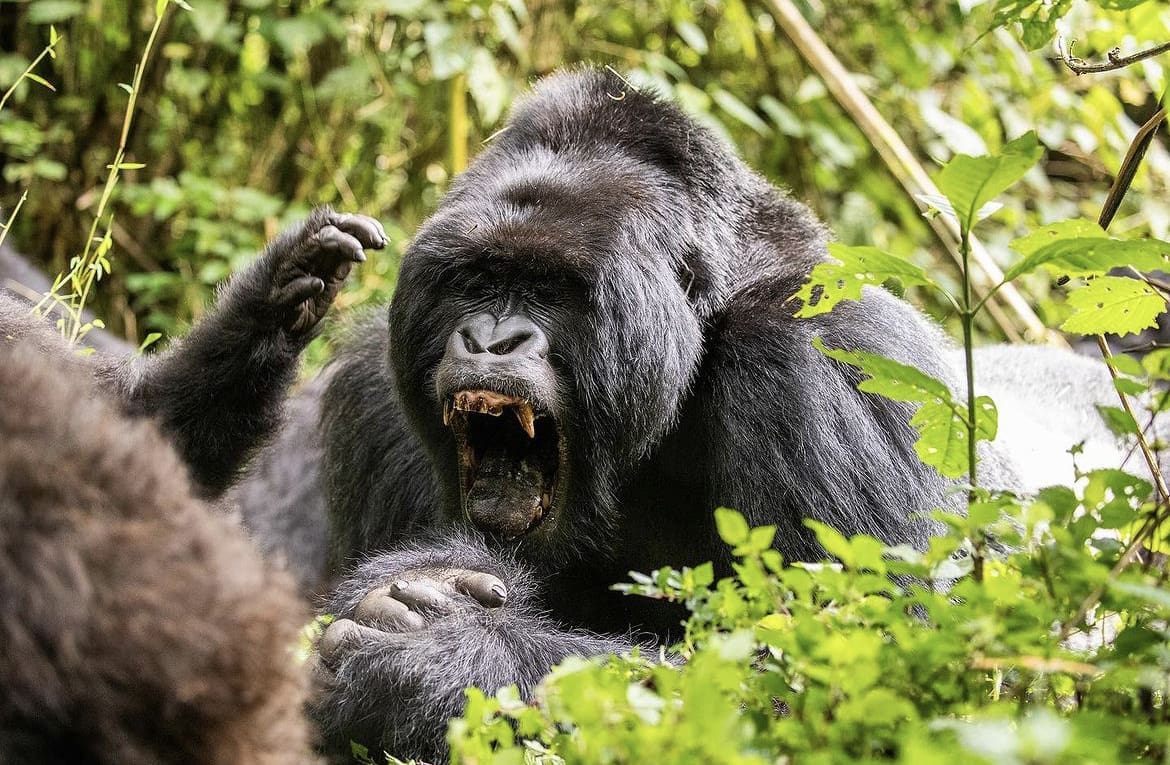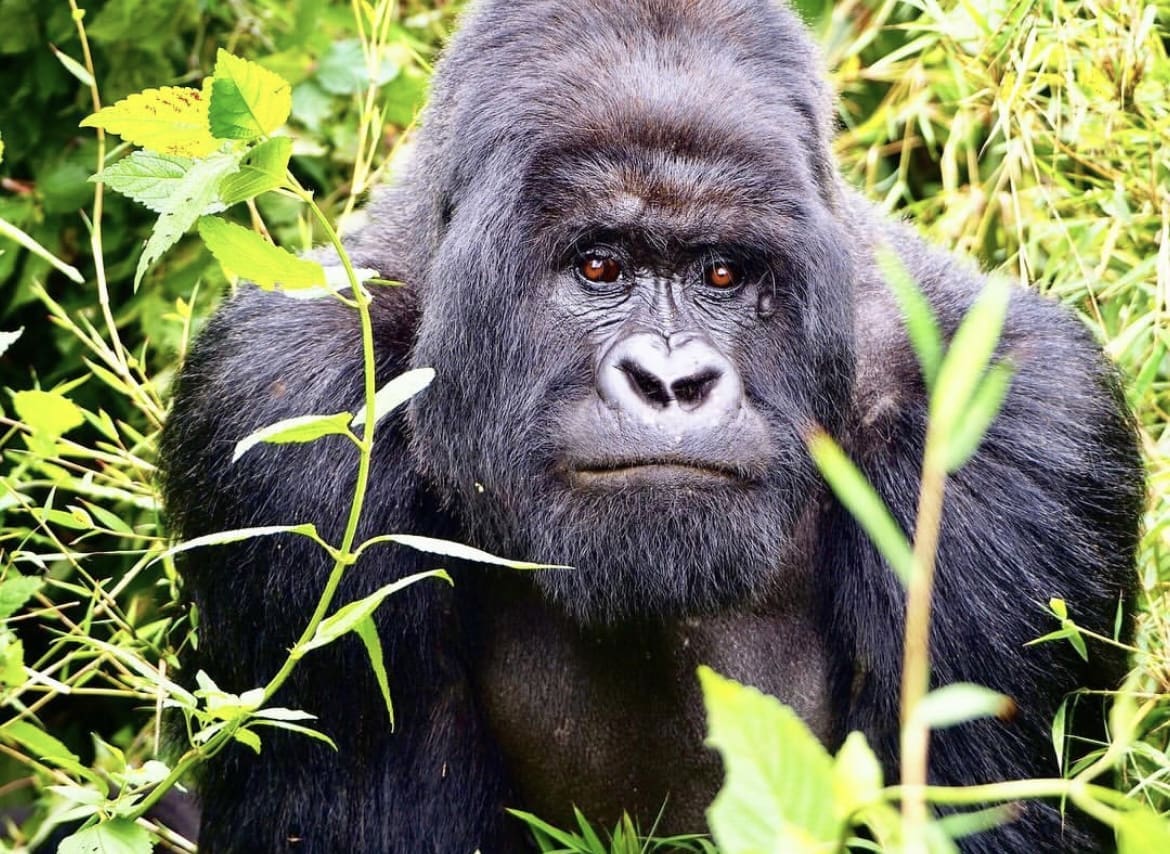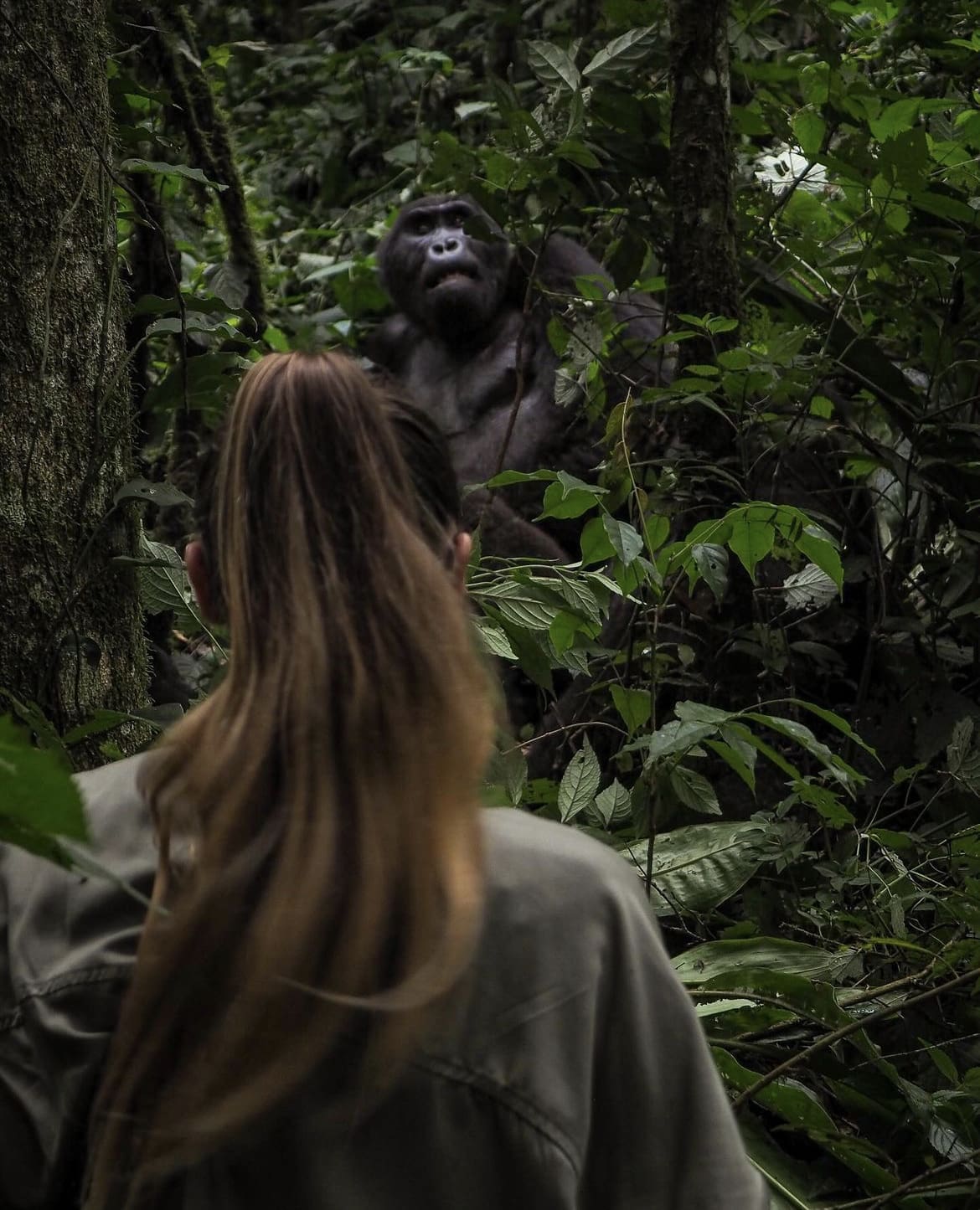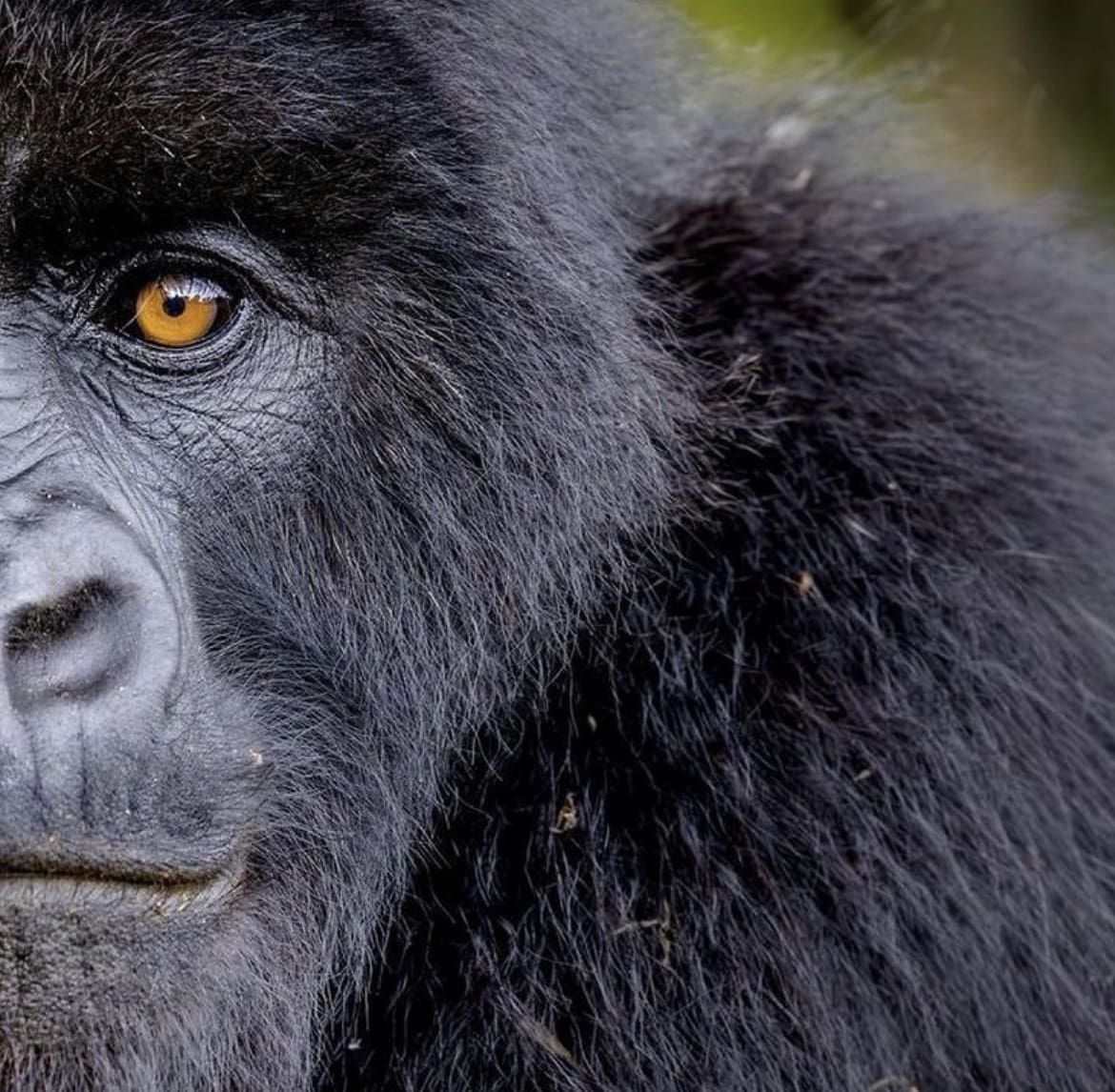In the misty mountains of Africa, you’ll find one the world’s most awe-inspiring creatures. Buckle up, because we’re about to get up close and personal with the Mountain Gorilla, a species that’s as enigmatic as it is endangered.
What is the Mountain Gorilla?
Mountain Gorillas are like the celebrities of the primate world, but without the paparazzi. These magnificent creatures are larger than life, both literally and figuratively, and they reside in the dense forests of central Africa. Scientifically known as Gorilla beringei beringei, these are not your average zoo gorillas. Nope, these guys are the more rugged, “live-off-the-land” type, making their homes on the volcanic slopes of Rwanda, Uganda, and the Democratic Republic of Congo.
What sets the Mountain Gorilla apart from its gorilla cousins is not just its address. It’s got thicker fur, which is a chic adaptation to the cooler climates of its high-altitude homes. Imagine wearing a fur coat all year round — that’s the mountain gorilla for you, always dressed to impress in its natural habitat.
Gorilla Species
Now, before we dive deeper, let’s sort out the family tree, shall we? In the gorilla family, there are four members: the Eastern Lowland Gorilla, the Western Lowland Gorilla, the Cross River Gorilla, and of course, our star, the Mountain Gorilla.
These species are spread out across Africa, each adapting and thriving in their unique environments. But here’s where our Mountain Gorillas stand out — they’re the more secluded, elusive celebrities of the bunch, living in areas that are not exactly your weekend getaway spots.

Gorilla vs Chimpanzee
And just because we’re on the topic, let’s clear up a common mix-up: Gorillas vs. Chimpanzees. Yes, they’re both primates, and yes, they both call Africa home, but the similarities pretty much end there. Gorillas are the heavyweights of the primate world, with Mountain Gorillas tipping the scales at up to 485 pounds for males. Chimpanzees, on the other hand, are more lightweight, and while they can throw a mean tantrum, they don’t quite match up to the sheer physical presence of a gorilla.
Behavior-wise, gorillas are the zen masters of the African forests, leading mostly peaceful, vegetarian lifestyles. They’re the contemplative philosophers, if you will, living in tight-knit families and spending their days munching on bamboo and leafy greens. Chimpanzees? They’re the party animals — more social, omnivorous, and, let’s just say, a bit more chaotic in their social structures.
What Do Mountain Gorillas Look Like?
Imagine the most distinguished gentleman you can, but make it a gorilla. Mountain Gorillas sport a luscious coat of thick, black fur that would make any fashionista green with envy. This isn’t just for looks, though; this fur is their built-in parka, keeping them warm in the chilly elevations of their mountainous homes.
Their expressive faces are framed with a silver-greyish hue as they age, especially in males, earning them the prestigious title of “silverback.” These guys don’t need Instagram filters to look good; they’re naturally majestic, with dark, soulful eyes that seem to tell stories of ancient forests and misty mornings.

How Big Are Mountain Gorillas?
When it comes to size, Mountain Gorillas are the bodybuilders of the primate world. Males can stand up to 6 feet tall when they’re showing off and trying to look impressive (imagine them on Tinder), and they weigh in at a hefty 350 to 485 pounds.
Females are a bit more petite, if you can call 200 to 250 pounds petite. These creatures are all muscle, built like the natural world’s version of a tank, but with a gentle touch. Their size is a testament to their vegetarian diet, which is pretty mind-blowing when you think about it. Who knew leaves and stems could bulk you up like that?
Mountain Gorilla Teeth
Let’s talk teeth. Mountain Gorillas have 32 teeth, the same as humans, but that’s where the similarities end. Their canines are nothing to scoff at; these pearly whites can be as long as 2 inches.
Why the impressive dental hardware? It’s not for tearing into a steak; remember, these guys are vegetarians. Instead, those canines play a crucial role in self-defense and showing dominance within their groups. It’s their way of saying, “Back off, buddy,” without having to throw a punch. Plus, their strong jaw muscles are perfect for their fibrous diet, allowing them to grind down tough plant material with ease.

What Do Mountain Gorillas Eat?
If you’re picturing a Mountain Gorilla throwing back a steak, think again. These guys are the ultimate vegans, with a diet that’s about as green as it gets. They feast on a smorgasbord of leaves, shoots, stems, and the occasional fruit to sweeten the deal. They’re not picky eaters, either; they have over 100 plant species on their menu. In a single day, an adult male can chow down on up to 34 kilograms (75 pounds) of vegetation.
That’s a lot of salad. This diet isn’t just about filling their bellies; it’s a delicate balance that ensures they get the necessary nutrients to maintain their bulky physiques and support their health. So, next time you’re munching on your greens, remember, you’re dining like a gorilla king.
Gorilla Social Structure
The social life of a Mountain Gorilla isn’t too far off from a human soap opera, minus the dramatic background music. They live in groups called troops or families, typically consisting of one dominant male (the Silverback), several females, and their offspring. This structure isn’t just for kicks; it’s a carefully maintained system that ensures the safety and well-being of the group.
The Silverback is the protector, decision-maker, and mediator. Think of him as the CEO of Gorilla Inc., managing everything from resolving disputes to deciding when it’s time to move in search of food. It’s not all about brute strength, though; Silverbacks also show a tender side, especially when it comes to caring for the young.

Silverback Gorillas
Speaking of Silverbacks, let’s shine the spotlight on these icons of the gorilla world. Earning the title of Silverback isn’t just about aging gracefully; it’s a symbol of power, wisdom, and responsibility.
These males are distinguished by the silver strip of hair running across their backs, a sign of maturity that usually appears around the age of 12. But being a Silverback is no walk in the park. It requires strength, both physical and mental, to defend the troop from threats, lead the search for food, and maintain order.
Yet, despite their imposing presence, Silverbacks are known for their gentle nature within the group, often seen playing with the youngsters or comforting a distressed troop member. It’s this balance of power and tenderness that cements their role as leaders and protectors.
Are Mountain Gorillas Aggressive?
When you picture a Mountain Gorilla, perhaps you envision a ferocious beast, ready to charge at any moment. Time to bust that myth: Mountain Gorillas are actually gentle giants. Aggression is not in their nature; they’re quite the peaceful creatures, preferring to live their lives without the drama. However, like any good protector, a Silverback will stand its ground and defend its troop if threatened.
This defense mechanism is more about show than actual aggression — think chest-beating, loud grunts, and mock charges. It’s their way of saying, “Move along, nothing to see here,” ensuring the safety of their family without resorting to violence. So, while they have the power to be fierce, they choose the path of peace, embodying the true spirit of gentle giants.

Are Mountain Gorillas Territorial?
Mountain Gorillas have a home range, but they’re not the “You shall not pass!” kind of territorial. Their home range can overlap with other gorilla groups, and they’re pretty chill about it. These ranges are more about finding enough food to sustain the troop than about staking claim to a piece of the forest. They’re nomadic, moving through their habitat in search of food, and they’ll make new nests each night as they roam.
This mobility shows their adaptability and their focus on the essentials — food and family — over territory. So, while they have their preferred dining spots and resting areas, they’re not about to start a turf war over them.

Where Do Mountain Gorillas Live?
Mountain Gorillas have a very specific real estate preference: they reside in the dense, cloud-shrouded rainforests of central Africa. You won’t find them in any old forest; they’re exclusive to the Virunga Mountains, which straddle the borders of Rwanda, Uganda, and the Democratic Republic of Congo, as well as the Bwindi Impenetrable National Park in Uganda.
These areas offer the rugged terrain and ample vegetation that Mountain Gorillas need to thrive. Living at elevations between 2,200 to 4,300 meters, they’ve adapted to a life amidst the mist, where the forests are thick and the foliage is plentiful. It’s not just about survival; it’s about sustaining a way of life that has evolved over millennia, one that is inextricably linked to the forest’s health and bounty.
How Many Mountain Gorillas Are There in Africa?
The question of how many Mountain Gorillas remain in the wild is one that carries both concern and a glimmer of hope. For years, these creatures were on the brink, with numbers dwindling due to habitat destruction, poaching, and disease.
However, thanks to concerted conservation efforts, their numbers have seen a slow but steady increase. As of the latest counts, there are over 1,000 Mountain Gorillas in the wild. This number is a testament to the resilience of the species and the success of international and local conservation initiatives. Each Mountain Gorilla is a symbol of hope, a reminder of what can be achieved when humanity comes together to protect and preserve our natural world.

Are Mountain Gorillas Endangered?
Despite the positive trends in their population, Mountain Gorillas remain classified as endangered. Their survival is a delicate dance, influenced by factors such as habitat loss, human encroachment, and the ever-present threat of poaching.
The forests they call home are also coveted for their resources, putting additional pressure on the already fragile ecosystems. Conservation efforts have made significant strides, but the battle is far from over.
Protecting Mountain Gorillas involves not just safeguarding their current habitats but also ensuring the forests can continue to support them and their fellow forest inhabitants for generations to come.
Threats to Mountain Gorillas in the Wild
The existence of Mountain Gorillas is besieged by a spectrum of threats, each a stark reminder of the fragility of their survival. Poaching, despite strict prohibitions, remains a sinister shadow, with gorillas caught in snares intended for other animals.
Habitat loss is another critical challenge; as forests give way to agriculture, mining, and human settlement, the natural home of the Mountain Gorillas shrinks further, pushing them into ever-smaller fragments of their once vast domains. Disease transmission from humans to gorillas poses a silent yet deadly threat, exacerbated by our shared genetic makeup.
These threats are not just statistics; they are urgent calls to action, compelling us to rethink our relationship with the natural world and the other beings that inhabit it.
Where to See Mountain Gorillas on Safari
For those seeking to witness the grandeur of Mountain Gorillas in their natural habitat, a safari in the heart of Africa is an unparalleled adventure. The Virunga Mountains, spanning Rwanda’s Volcanoes National Park, Uganda’s Mgahinga Gorilla National Park, and the Democratic Republic of Congo’s Virunga National Park, offer the rare opportunity to encounter these gentle giants up close.
Uganda’s Bwindi Impenetrable National Park is another sanctuary, home to nearly half of the world’s Mountain Gorilla population. These parks are not just wildlife viewing destinations; they are vital centers for conservation and research, where every visit contributes to the ongoing efforts to protect these magnificent creatures.

Tips for Spotting Mountain Gorillas in the Wild
Embarking on a gorilla trek is no ordinary journey; it’s an expedition into the heart of the forest, a privilege that comes with a responsibility. To increase your chances of a sighting while respecting the gorillas’ natural environment, follow these tips:
- Hire a knowledgeable guide: Local guides are invaluable, not only for their tracking skills but also for their insights into gorilla behavior.
- Keep a respectful distance: While encounters can be close, maintaining a 7-meter distance is crucial to prevent stress to the gorillas and reduce the risk of disease transmission.
- Be patient and quiet: Gorillas are more likely to be at ease in your presence if you observe them in silence and without sudden movements.
- Follow the rules: Guidelines are in place for the safety of both visitors and gorillas. Adhering to them ensures a harmonious experience for all.
Facts About Mountain Gorillas
- Mountain Gorillas share approximately 98% of their DNA with humans, highlighting our profound connection to these creatures.
- They have a lifespan of around 35-40 years in the wild, with each individual playing a pivotal role in the social fabric of their troop.
- Gorilla tourism, when conducted responsibly, is a powerful tool for conservation, providing the financial resources necessary for ongoing protection efforts.

Myths about Mountain Gorillas
Mountain Gorillas have often been cast in the shadows of myths and misconceptions, painted as ferocious beasts lurking in the depths of the forest. It’s time to shed light on these myths and reveal the truth about these gentle giants:
- Myth: Gorillas are aggressive and dangerous to humans. Truth: Mountain Gorillas are inherently shy and peaceful. Aggression is rare and usually a defensive behavior rather than unprovoked hostility.
- Myth: Gorillas can easily adapt to captivity. Truth: Gorillas have complex social and environmental needs that are difficult to replicate in captivity, making their survival outside their natural habitat challenging.
- Myth: They have no natural predators. Truth: While adult Mountain Gorillas have few natural predators due to their size and strength, human activities pose significant threats through habitat destruction and poaching.
As our journey with the Mountain Gorillas comes to a close, it’s clear that these creatures are more than just subjects of awe and wonder; they are a vital part of our world’s biodiversity, deserving of our utmost respect and protection. The story of the Mountain Gorilla is one of resilience in the face of adversity, a testament to the power of conservation efforts, and a reminder of the fragile balance between humans and nature.
Encountering Mountain Gorillas in the wild is a privilege that comes with significant responsibility. As guardians of their legacy, we are tasked with ensuring their survival, not just for their sake but for the health of our planet. Supporting conservation initiatives, advocating for sustainable practices, and educating others about the importance of these magnificent creatures are ways we can all contribute to their preservation.
